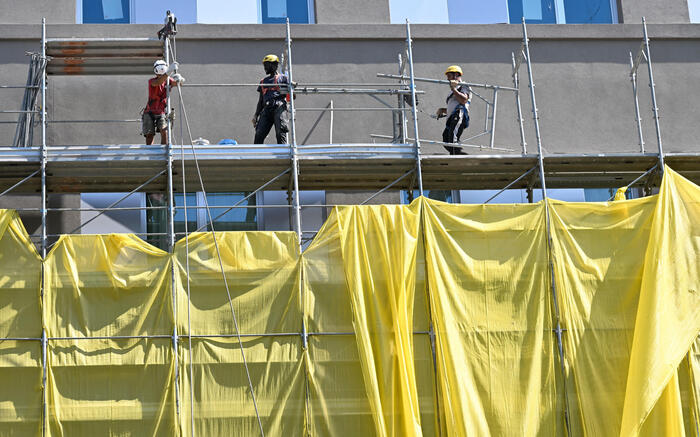The slope stabilization work on the quarry on Blomberg has been going on for a good two weeks.
Ranger Manuel Wilke gives an insight into the construction work on site.
Wackersberg
- The measure was already on the to-do list on the Blomberg for a long time: slope stabilization work in the upper area of the toboggan run.
First the corona pandemic delayed the beginning, then the bad weather (we reported).
In the meantime, however, the work has been in full swing since April 19.
The first part of the cable car route has already been completed.
A stable net now firmly holds back the slope.
“There were already rocks on the hiking trail in 2019,” explains Blomberg ranger Manuel Wilke.
Construction work scheduled for three weeks
The section that needs to be secured at the quarry is much longer.
Here the workers are still at work these days.
From Monday to Friday they are usually busy for more than ten hours to pave the slope as quickly as possible and to ensure that the hiking and tobogganing path is no longer buried by the sliding flysch debris.
Flysch is the deposit that the Isarwinkel glacier left behind.
The material consists mainly of sand and clay.
Not least because of this composition, erosion and slope movements are to be expected on the one hand, and have already arrived visibly at the prominent places on the other.
+
The first network on the toboggan run has already been completed.
Manuel Wilke shows the finished anchors.
© arp
The advancing erosion can be intercepted and stopped with the help of special nets.
“It's all a bit more complex, because you can't just take something away from the slope because more flysch would follow immediately,” explains Wilke.
A network was attached to the quarry many years ago, but it no longer rests firmly on the slope and can therefore no longer safely hold back the rubble.
Networks on the slope generate security
The workers at the Innsbruck-based specialist civil engineering company HTB are carefully removing the network.
"You have to be very careful and can only cut small holes in order to work your way slowly," explains civil engineering worker Fabian Geisler from the Zillertal.
Because: If you were to remove the entire old net in its entirety, acute rockfalls are to be expected, he says, while he hangs securely on the slope and examines the structure in order to determine the right place for the next anchor.
Anchors are cemented three meters deep into the slope
The experts work their way up bit by bit, free the area from the old net and check where they need to set anchors.
In Flysch rocks, these anchors have to be drilled and cemented three meters deep so that they can generate the best possible hold.
"With Flysch you need a very solid and deep foundation so that the construct really holds," explains Wilke and demonstrates on a piece that has fallen off how fragile the material is in his hands.
+
Markus Stadler prepares the cement.
As soon as the drill is set, it flows into the anchorage.
© arp
How many new drill anchors need to be set is not exactly clear in advance. Fabian Geisler checks the spots on the slope. His colleague Georg Gredler is meanwhile sitting in the excavator and is ready with a special drill attachment - a so-called drill carriage - to maneuver the anchor into the slope. A little further above stands foreman Markus Stadler. All three workers are always in contact by radio. Stadler prepares the cement, which runs downhill through a thin pipe and is attached directly to the attachment for the drill. In this way, the liquid concrete also runs into the anchorage parallel to the drill. "So far we have bored up to 20 such anchors per day," reports Geisler. “But it takes a different amount of time for everyone - depending on how quickly the holes fill up. Flysch material is a special challenge for this,it always takes a little longer, like a compact rock, and you need a lot more cement. "
Total cost for the city: 65,000 euros
As soon as the new network is fully installed at the quarry, this picture will not beautify the hiking trail for the time being, but Wilke reassures him: "Everything grows back very quickly in the places and soon you will hardly see anything of the network".
As little as possible had been felled in advance when "clearing the slope".
“We always tried to protect the vegetation.
Because the fewer trees, the more erosion, ”the Blomberg ranger knows.
According to the plan, it will take until May 7th until the slope stabilization is completely finished.
The total cost of the operation for the city of Bad Tölz is around 65,000 euros.
Bad Tölz newsletter:
Everything from your region! Our brand new Bad Tölz newsletter informs you regularly about all the important stories from the Bad Tölz region - including all the news about the corona crisis in your community. Sign up here.









